How To Spray Art Varnish On Drawings
If you are working with mixed media, the best display solution is ordinarily behind UV-protective glass. This provides ultimate protection against UV-light, dirt and dust. If you decide against mounting behind glass, then varnishing or pinnacle coating can be the next all-time option, however, that can become tricky when mixed media pieces incorporate sensitive materials. Varnishing nigh always introduces visual changes to artworks and depending on the materials, these changes tin can be permanent. Thus, the first question is, whether information technology is worthwhile to have that chance. Our video "Should you Varnish your Painting?" and JP article "Tips and Tricks for Varnishing" bargain with this question.
When varnishing mixed media pieces it is of import to be aware of the properties and sensitivities of each material nowadays in the artwork. The most sensitive fabric in the piece usually dictates if, how (brush or spray) and with which varnish, fixative, or topcoat the artwork can exist coated. If unsure, each cloth in the artwork should be tested for sensitivity on a sacrificial test piece. Additionally, some materials practise not have varnishes and no suitable coating would adhere to these. What follows is a list of materials that are frequently used in mixed media and things to consider when wishing to varnish these materials.
Oil & Wax Pastels

Oil pastels are made with non-drying oils and wax, which means they never dry out or cure. This tin exist a groovy characteristic as they remain workable indefinitely, but information technology makes varnishing pretty much impossible as subsequent coatings do not adhere on these pastels permanently. Image 1 shows detail of a wax crayon painting that was completely painted over in oil. The oil layers seemed to attach at first, only several years later, cracked open and delaminated. Although nosotros have no long-term testing of Gilt Varnishes over oil and wax pastels, we would await similar results and do non recommend varnishing these materials at all.
Artists who wish to utilise a varnish or fixative on their oil pastels despite the gamble of future delamination volition probable encounter a second trouble, namely tackiness. Especially softer oil pastels remain tacky, also when varnished. In our testing nosotros constitute that GOLDEN Archival Varnish Gloss remains very tacky over some oil pastels, also when applied as a second coating over diverse fixatives. Fixatives comprise significantly less binder than a varnish and therefore might perform better on these pastels in terms of tackiness. Of the Sennelier Oil Pastel Fixative and the Lascaux Fixative, the Sennelier product gave the best results, with the oil pastel remaining tacky only e'er so slightly. However, product formulations can always change without notice and testing remains essential.
⇒ Oil and wax pastels do not cure and are best shown backside glass. We exercise not recommend varnishing, merely if varnishing is attempted, follow manufacturer's recommendations for sealants and fixatives.
Graphite Pencil
Everybody is familiar with graphite pencils. Only who knew that graphite is besides a so-called 'dry lubricant'? Graphite is often used to lubricate valves, locks, joints, brawl bearings, etc. As one tin imagine, adhesion of any coating on a lubricant isn't not bad. Now, pencils consist not only of graphite. The atomic number 82 of a pencil contains graphite as paint, clay every bit binder and grease and wax every bit impregnating agent, which as well allows for smoother abrasion and better writing ability of the pencil. The college the clay content, the harder the pencil. So, if harder pencils contain more clay, is it easier to varnish those? We carried out adhesion tests on pencil marks made with pencils (by Faber-Castell) of various hardness, on canvas lath that was painted with Fluid Matte Cerulean Blue. We plant that after ii weeks of drying time Gold Varnishes had good adhesion on soft and on hard pencil marks, while the Isolation Coat indeed had better adhesion on harder pencils (Image 3). When nosotros tested the varnishes and the Isolation Coat after only 4 days (Epitome 4), there were failures on soft as well as on hard pencils. However, the solvent based MSA and Archival Varnishes performed significantly ameliorate compared to the water based Isolation Coat and the Polymer Varnish.
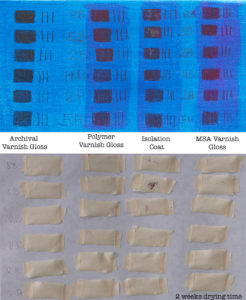

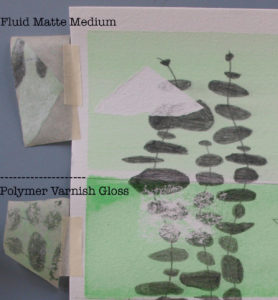
On newspaper the story was quite unlike (Epitome v). Varnished pencil on paper had such practiced adhesion that the record used in the testing tore the paper. Thus, the bond of the varnish to the pencil was stronger than the internal newspaper bond.
Harder pencils besides resist smearing and bleeding ameliorate when brush- coated with wet acrylic production. We found that 2B or harder pencils can be brushed over with Polymer Varnish, for example, without lifting the graphite (Image 6). Nevertheless, we only tested one make of pencil, namely Faber-Castell, and results may vary with other brands. When castor varnishing graphite drawings, which consist only of a few lines, it can help to apply an acrylic medium on tiptop of the drawing first, thereby following the graphite line closely. Alternatively, using the smearing to create shadows or shading could exist used as a technique.
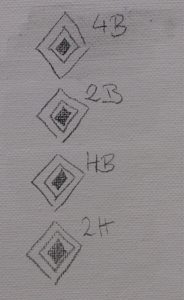
For some artists, who love the wait of graphite in their mixed media works, Gilt Graphite Gray (#1160) might be a viable alternative. The product is highlighted here.
⇒ Graphite is a dry lubricant and adhesion of subsequent coatings tends to exist poor. For artworks with large and thick areas of graphite, nosotros recommend not to varnish at all. In our testing, the adhesion of Gold Varnishes improved considerably after about 2 weeks of drying. Since graphite is water soluble, the MSA and Archival Varnishes may be the better option, since they are less likely to smear and tend to attach better to graphite than the water based Isolation Glaze and Polymer Varnish.
Charcoal, Crayons & Soft Pastels
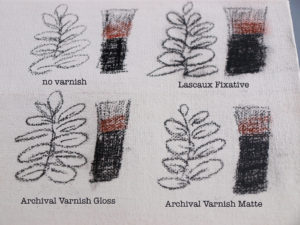
When varnishing dry media, the chief issue is usually the change in appearance, that can bear upon color saturation, colour value, surface sheen and the general grapheme of the surface (Paradigm 7). There is a fine line between barely fixing the drawing and saturating it to the extent that the pigments are actually surrounded in varnish and thus secured to the substrate. Fixatives are not meant to protect or encapsulate the media completely, but to prevent some of the lifting, which is why they are usually called "workable". If the fixative is very thin, pigments can even so lift when the surface is rubbed, merely the appearance of the dry mark is preserved better. How sensitive charcoal and soft pastels is demonstrated hither. Therefore, spraying may be the best possibility to employ varnish then that mechanical action on these surfaces is avoided. Some artists prefer Matte Varnishes to truly protect their drawing and preserve a little of the matte sheen, natural to charcoal, soft pastels and similar media.
⇒ Light spraying of mediums or varnishes deed more like fixatives and drawings tin can remain prone to pigment lifting, but retain more of their dry media character. Heavier coats of varnish provide better protection, merely can cause more than change in color values, saturation and surface sheen.
Colored Pencil
Colored pencils are wax or oil based, which makes long term adhesion of subsequent varnishes and topcoats problematic. The oil and wax content likewise makes them sensitive to many organic solvents that are common in varnishes. In addition, colored pencils also contain additives such equally thickeners, preservatives, humectants, and surfactants, whereby peculiarly the latter tin make them sensitive to water. Additionally, h2o borne acrylic products also require surfactants in their formulations and so are more than likely to smear out a colored pencil drawing when information technology'southward brush-coated with Polymer Varnish, for example. At the same fourth dimension we know, however, that many artists utilize our acrylic mediums over colored pencils successfully and testing on a case by instance basis would be necessary. Results tin vary because there are many different types of colored pencils out in that location. Due to this variability we would consider this application experimental.
Nosotros have not done extensive adhesion tests of our varnishes on colored pencils and simply sampled the adhesion of Archival Varnish Gloss on the oil based artist pencil by Faber-Castell and wax based pencil by Staedtler, which proved excellent after 2 weeks of drying.
⇒ We do not recommend our varnishes over wax or oil based colored pencils, due to potential adhesion problems in the long run. For those who however want to varnish or topcoat colored pencils nosotros would recommend to examination kickoff and check pencil manufacturers' recommendations.
Pens & Markers
The variety in markers available to artists is tremendous so that case by case testing for potential sensitivities is unavoidable. Pens and markers can drain when spray varnished and smear when brushed over. I might call up that a permanent pen could be brushed over with a water based varnish and a pigmented (vs. ink) pen could exist coated with a solvent based varnish without bleeding. We tested some twenty pens and markers and plant:
- I really needs to test!
- Permanent pens and markers, whether ink or pigment-based, can smear and bleed significantly when coated with h2o based Polymer Varnish or Isolation Coat. We had similar results when testing alcohol inks with GOLDEN Acrylics and Varnishes.
- On paper substrates the Archival Varnish (and other solvent based varnishes and fixatives) tin can saturate the paper and crusade ink to become very visible on the reverse of the paper, which is more relevant when varnishing works in sketch books where both sides of a newspaper contain artwork.
- Nigh creative person-quality pens and markers that we tested did non drain when sprayed with Archival Varnish merely at that place can be a slight color shift in ink-based markers.
The label 'permanent' on markers likewise often leads to misunderstanding. On pens, like Sharpies for instance, this label refers to the fact that the pen marks are permanent on wearables when laundered or put in a dryer. It does not hateful that these markers are lightfast, not even when varnished.
⇒ Creative person-quality pens and markers tend to be to the lowest degree problematic when varnishing, simply testing remains essential.
Watercolors
We accept two articles on varnishing watercolors, which really help to understand what kind of changes a watercolor can undergo through varnishing. The bottom line is, young watercolor paintings are sensitive to aqueous mediums and varnishes and therefore are best spray varnished. See: Aesthetics of Varnishing Transparent Watercolor and Aesthetics of Varnishing Transparent Watercolor: Creating the Least Modify.
Papers and Prints
Decorative craft papers or prints are ofttimes used in collages and varnishing these can exist an choice, if the paper elements are in whatever way covered with acrylic medium or paint. Nonetheless, if that is not the case, varnishing could significantly change the advent of the paper, by saturating or darkening its color, changing gloss, or texture (Image 8). If using MSA or Archival Varnish directly on sparse papers like rice paper or magazines, this could besides cause the paper to become transparent and in the example of magazines and newspaper, one would and so exist able to see the print on the other side through the forepart.
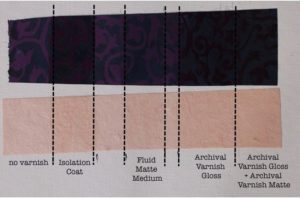
As a general rule h2o and ammonia sensitivity tends to be less of a concern with light amplification by stimulated emission of radiation jet prints than with inkjet prints and photographs, although toners are continuously changing and information technology seems that inkjet prints are less water sensitive now than they were in the past. We do not recommend any of our products on bodily photographs (traditional photographic emulsion developed from films), since they would be destroyed by a water or solvent based product and which is why photographers always frame nether drinking glass. We just don't want anyone to adventure destroying their precious photographs. We take likewise seen some solvent sensitivity with traditional dye sublimation photos, which can outcome in bleeding, blurring and colour changes. Here you will find great tips on coating inkjet prints and this article describes lightfastness testing of pigment and dye-based inks. We institute that Archival Varnish due west/UVLS and MSA Varnish w/UVLS, besides as a handful of other brands which are named in the article, protect prints significantly against fading. Testing your products would always be recommended.
⇒ The saturation of decorative papers tin cause significant color shifts towards darker values and previous testing is required to decide whether these changes are acceptable. Present there is a lot of variability with the many types of prints and these products are moving targets. Therefore, private testing of the products is necessary.
Conclusion
Once information technology has been established which cloth of a mixed media slice is the most sensitive, the appropriate varnish and application method tin be tested and practical. If all the same, collage materials take sensitivities that would crave contradicting approaches, and so it might be an option to varnish sure materials before applying them to the collage or applying unvarnished materials onto a varnished mixed media piece. This certainly requires that i thinks well-nigh varnishing during the creative process. We would consider such layering experimental, since applying more artwork over removable varnishes always puts these height layers at risk of being inadvertently removed during a hereafter varnish removal. In such a case we would besides recommend applying a notation on the reverse of the artwork, which indicates how the diverse elements have been varnished.
Further Reading
More information on varnishing tin be constitute in our Varnishing Resources.
Farther reading on materials:
Waterproof India Inks and Shellac-based Primers
Using Booze Inks with Golden Acrylics and Varnishes
Acrylics on Gold Leaf
Why Oil Painting Over MSA or Archival Varnish Is Non Recommended
Categories of Wax-Based Drawing Media
Source: https://justpaint.org/varnishing-mixed-media-paintings/
Posted by: stewartquidents53.blogspot.com



0 Response to "How To Spray Art Varnish On Drawings"
Post a Comment